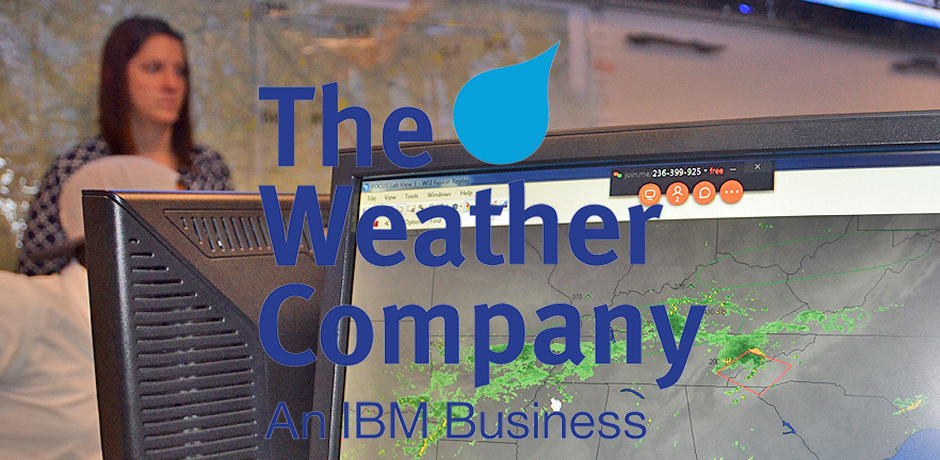Middle Tennessee State University aerospace students are finally getting the chance to receive hands-on training — and a leg up in the job market — using a state-of-the-art aviation program donated earlier this year.
WSI Fusion is an aviation operations management solution and was donated by Southwest Airlines and The Weather Company, an IBM business, in the spring. The technology has been implemented in the Department of Aerospace’s NASA Flight Operations Center-Unified Simulation labs, better known as FOCUS labs.

MTSU associate aerospace professor Andrea Georgiou trains students on new weather software recently inside the Business and Aerospace Building. The WSI Fusion software, an aviation operations management solution, was donated by Southwest Airlines and The Weather Company in the spring. (MTSU photos by Steven Michael Johnson)
A group of over a dozen graduate and undergraduate students from the College of Basic and Applied Sciences is the first to receive training for the software before it becomes open to all aerospace and industrial organizational psychology majors.
WSI is the same state-of-the-art technology Southwest Airlines uses currently and it allows users to obtain real-time flight and aerospace data. The system can also process data and enables users to make more precise operational decisions.
 WSI also stores information from all Southwest flights, meaning MTSU professors can use information from these flights — such as weather patterns, altitude and detours — to implement different training scenarios that wouldn’t be possible without the technology.
WSI also stores information from all Southwest flights, meaning MTSU professors can use information from these flights — such as weather patterns, altitude and detours — to implement different training scenarios that wouldn’t be possible without the technology.
This unique experience and access to information is regarded as WSI’s most beneficial aspect to students and has instructors excited about the possibilities.
“Before we received this we had to use whatever weather would occur on that day. Now with this captured weather, we can run them through thunderstorms, severe wind and other different scenarios,” said associate professor Andrea Georgiou as students trained recently at the FOCUS Lab inside the Business and Aerospace Building.

MTSU aerospace students train on new weather software recently inside the Business and Aerospace Building. The WSI Fusion software, an aviation operations management solution, was donated by Southwest Airlines and The Weather Company in the spring.
Georgiou also stated the new scenarios introduced by WSI will improve research in the department as well as increase the emphasis on teamwork for students throughout the program.
Graduate student Jordan Gunn, who attended hands-on training for the program in Dallas with Georgiou, said the learning curve wouldn’t be as steep as expected for students.
This is due in large part to a very user-friendly interface that allows for students to customize their versions of the program to their liking, he noted.
“I’ve been around weather all my life, so getting used to the program was easy. It’s very user-friendly and includes a help book that can honestly tell you how to do just about anything,” said Gunn.
“It’s a unique program, but one that most students won’t have much trouble getting used to.”
While learning how to operate the system may not be as challenging as expected, Gunn said the situations will be rigorous and will test students’ knowledge like never before.
 “I think students will be better prepared, because mostly they’re told what the weather situation is. With this technology, now you can see how they react to certain random weather phenomena and make them ask themselves how they can be better prepared for the weather and other situations on this day,” Gunn said.
“I think students will be better prepared, because mostly they’re told what the weather situation is. With this technology, now you can see how they react to certain random weather phenomena and make them ask themselves how they can be better prepared for the weather and other situations on this day,” Gunn said.
Because MTSU is the first school with this technology, Georgiou said she sees the aerospace department taking a major step forward and the students reaping the benefits as a result.
“The industry is beginning to find out about this and they love it. Now when employers see ‘MTSU NASA FOCUS Lab’ on resumes, our students are getting more jobs, internships, and their careers are advancing quicker,” she said.
Training for the program will continue throughout the semester, and Georgiou said MTSU alumni are already volunteering to return to campus to help assist students in their training.
For more information about MTSU’s aerospace program, go to www.mtsu.edu/aerospace or call 615-898-2788.
— Steven Michael Johnson (news@mtsu.edu)

MTSU aerospace students train on new weather software recently inside the Business and Aerospace Building. The WSI Fusion software, an aviation operations management solution, was donated by Southwest Airlines and The Weather Company in the spring.


COMMENTS ARE OFF THIS POST